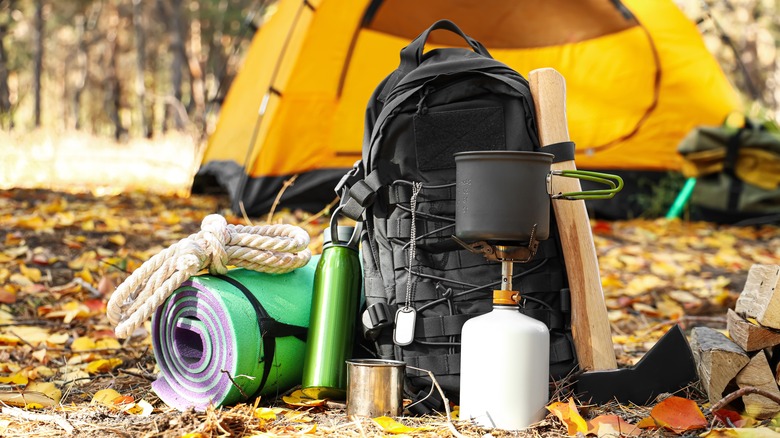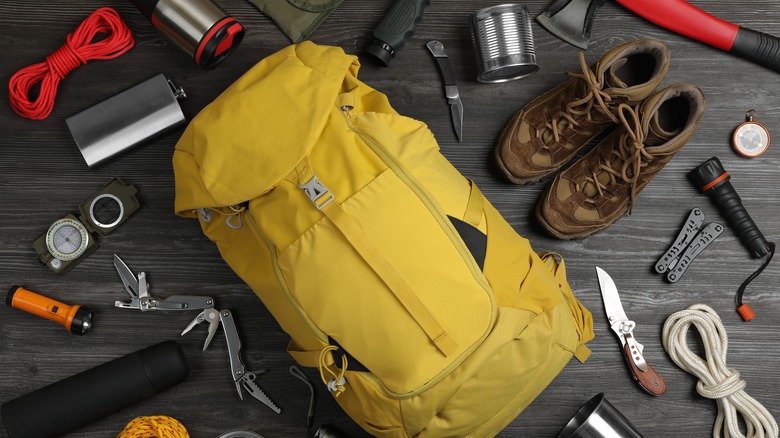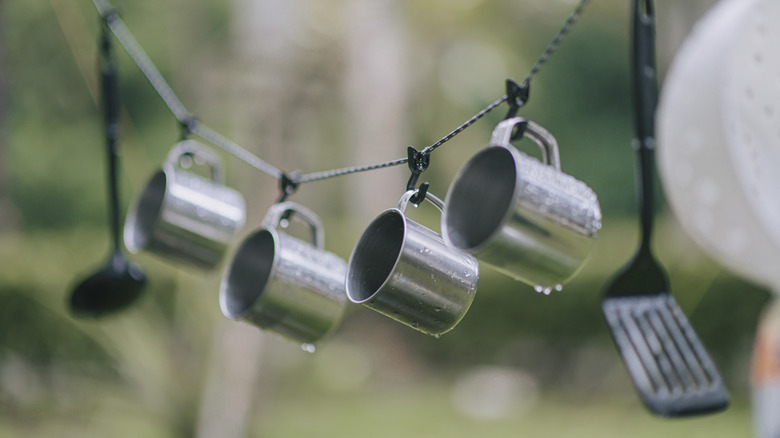Clever Ways To Keep Your Camping Gear Dry
We may receive a commission on purchases made from links.
No matter what the forecast says, Mother Nature often finds a way to keep things interesting. But the truth is, even without an abrupt change in the weather, camping supplies and cookware have a tendency to build up moisture, which can lead to mildew, rust, and an unpleasant odor. It's a shame to open your camping kit and find your favorite gear ruined, especially if it cost a small fortune. Luckily, a few simple, cost-effective hacks can help you tackle the moisture problem.
The first solution is something you probably already have. You know those little silica gel packets inside packages like shoes, books, electronics, and beef jerky? Instead of tossing them out, reuse them for your camping gear. You can also order 100 two-gram silica gel packets on Amazon for under $10. These desiccants — materials that absorb moisture from the air to create dryness — are artificial, but you can also use natural materials from your pantry, like rice or oatmeal. Toss a few silica gel packs or a cloth bag with rice or uncooked oats inside your tent, cookware, and anything else you want to keep dry.
Invest in water-resistant or waterproof gear
As you build your camping collection, invest in materials that come in water-resistant or waterproof materials, including backpacks, tarps, tents, cookware, sleeping bags, and blankets. In fact, anytime you need to purchase something camping-related, see if there's a waterproof version available. You'd be surprised just how often there is. Include smaller items in your search, like binoculars, lanterns, utensils, campfire starters, and socks.
If you tend to camp in dry conditions with the occasional storm, water-resistant materials might be for you. They tend to be more breathable, making clothes and shoes feel more comfortable and flexible on the trail. On the other hand, regions like the Pacific Northwest require a bounty of waterproof gear — yes, even socks — as the area is more prone to regular rain and fog. Though waterproof materials feel more restrictive, they're fully sealed from outside moisture.
For your existing items, one DIY solution is to use waterproof sprays and waxes. Keep in mind that the process could take a few days, so leave enough time for the project before your trip. Some popular products for tents and gear include KIWI Camp Dry and GEAR AID Seam Grip, which can repair holes and tears. For fabrics, consider Scotchgard Outdoor Water Shield Fabric Spray, which works on polyester, nylon, cotton, leather, and suede, among other materials. For your hiking boots, Otter Wax will do the job beautifully.
Tips to keep gear dry in the wild
Packing is an art form, especially when you're trying to keep things dry. Look around your house for waterproof cases, like empty food containers, plastic bottles, or small glass jars. You can use old sardine cans for smaller items like matches, lighters, medication, and bandages. Line your backpack with a large garbage bag or polyester dry bag. As you pack, prioritize the items you want to keep dry in the center of the bag, surrounded by waterproof things. Bring your electronics in small plastic bags with a seal, or use a waterproof cell pouch.
Once outdoors, set up your campsite on a patch of land with a slight slope so rainwater runs downhill, instead of pooling under your gear. Avoid camping near a low-lying river or ravine that could flood during a storm, per the National Park Service. When it's dry and sunny outside, set up a clothesline to dry your towels and clothes, and use S-shaped hooks to hang your cookware. Use a tarp or canopy to cover your picnic area, held up by branches, sticks, or ropes secured around nearby tree trunks (like you would with a hammock). Out of everything, focus on keeping your clothes and sleeping bag as dry as possible. If you play your cards right, you'll be able to fall asleep to the sound of raindrops inside a warm, dry tent. Sweet dreams.


